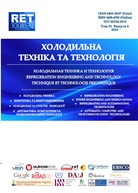EXPERIMENTAL AND CALCULATIONAL STUDIES OF THE NANOPARTICLE Al2O3 ADDITIVES ON THERMALPHISICAL PROPERTIES OF REFRIGERANT R600a-COMPRESSOR OIL SOLUTIONS
DOI:
https://doi.org/10.15673/0453-8307.4/2015.44780Keywords:
Nanofluids, Refrigerant/oil solutions, Viscosity, Saturation vapor pressure, Surface tension, Experiment, Calculation methodsAbstract
The results of experimental and theoretical studies of the effect of Al2O3 nanoparticle additives on the viscosity, saturation vapor pressure, surface tension of R600a/mineral oil solutions are presented in the article. The model SP-QSPR - Skaling Principles - Quantitative Structure-Property Relationship to describe the experimental data and predict nanofluid thermophysical properties at wide range of parameters of state has been applied for the first time. It has been shown, that viscosity increase, saturation vapor pressure and surface tension decrease for refrigerant / oil solutions with additives of nanoparticles. These effects should be considered at assessment of nanotechnology prospects in the refrigeration equipment.
References
Xiang-Qi Wang, Arun S. Mujumdar 2008. A Review on Nanofluids – Part I: Theoretical and Nu-merical Investigations Brazilian Journal of Chemical Engineering. Vol. 25, No. 04, 613-630. doi: 10.1590/S0104-66322008000400001
NIST Thermodynamic properties of refrigerants and refrigerants mixtures database (REFPROP) Version 7.1 M. O. McLinden, S. A. Klein, E. W. Lemmon, A. P. G. Peskin – Gaithersburg: National Institute of Standard and Technology. – 2003
Zhelezny, V., Sechenyh, V., Nikulina, A. A New Scaling Principles–Quantitative Structure Property Relationship Model (SP-QSPR) for Predicting the Physicochemical Properties of Substances at the Satu-ration Line. Journal of Chemical & Engineering Data, №59 (2), 485–493. doi:10.1021/je400933x
Zhelezny, V.P., Semenyuk, Yu.V., Lozovskyy, T.L., Markvart, A.S. 2012. Prediction methods of pseudocritical parameters for refrigerant/oil solutions. Vestnyk MAKH [Vestnik of International Academy of Refrigeration], №1, 48-52. (in Russian)
Hryhor'ev, B.A. 1999. Thermophysical properties of oil, petroleum, gas condensates and their fractions / B.A. Hryhor'ev, H.F. Bohatov, A.A. Herasymov. - M: Yzdatel'stvo MЭY. – 372 p. (in Russian)
Zhelezny, V.P. Cheremnykh, Y.V., Bisko, E.G. 1999. New vapor pressure equation for non-associated substances. High Temperatures – High Pressures. Vol.31, № 2, 163-168. doi:10.1068/htec252
Skripov, P. V. Starostin, A. A., Volosnikov, D. V., Zhelezny, V. P. 2003. Comparison of thermophysical properties for oil/ refrigerant mixtures by use of pulse heating method International Journal of Refrig-eration. Vol.26, Iss. 3., 721-728. doi:10.1016/S0140-7007(02)00163-9
Lozovskyy, T. L., Semenyuk, Yu. V., Ivchenko, D. A., Prykhodchenko, N.A., Zhelezny, V.P. 2009. Surface tension of refrigerant mixtures and refrigerant/oil solutions. Experiment, prediction methods. Part 3: Surface tension of refrigerant/oil solutions. Kholodyl'naya tekhnyka i tekhnologia [Refrigeration Engineering and Technology]. № 6 (122), 38-46. (in Russian)
Zhelezny, P.V. Zhelezny, V.P., Procenko, D.A., Ancherbak, S.N. 2007. An Experimental Investigation and Modelling of the Thermodynamic Properties of Isobutane - Compressor Oil Solutions. Some Aspects of Experimental Methodology. International Journal of Rerigeration. Vol.30., Iss.3., 433 – 445. doi:10.1016/j.ijrefrig.2006.09.007
Nikulina A.S. 2014. Prediction of the thermophysical properties for the multicompo-nent solutions with undefined composition: dys. kand. tekhn. nauk. – Odessa.– 163 p. (in Russian)


